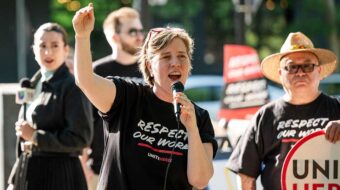
NEW YORK—“Thud! Dead. Thud! Dead.”
That’s how one onlooker later remembered the tragedy of New York’s Triangle Shirtwaist Factory fire of 1911, just off what is now Washington Square Park in lower Manhattan. It was the thud and death of the 146 immigrant women and girls, trapped in a sweatshop so far up the Asch Building that when fire broke out—and the owners had barred and locked the doors – they had no choice but to jump out the windows. The fire escape, such as it was, didn’t reach that high, either.
Now, finally, 112 years after the tragedy and its aftermath, there’s a permanent memorial to the victims, and to the role their deaths played in U.S. history.
The memorial was dedicated on October 11. In the three predominant languages of those immigrant workers—Yiddish, Italian, and English—it tells the story not just of those young women on that fateful Saturday, but of the progressive forces their fate set in motion. Those forces still drive much of labor law and building code laws today.
Among the horrified onlookers as the bodies crashed onto the sidewalk was a young social worker, part of the middle- and upper-class progressive movement. She saw the fate of those young immigrant women, trapped on the ninth floor of the factory in what is now the Brown Building, part of New York University. And Frances Perkins realized she had to do more.
After all, while the fire burned quickly, the ladder trucks of 1911 couldn’t reach that high.
The way the laws were written in 1911, the factory owners got away scot free from penalties. Never mind that they had locked the doors to “prevent theft.” Never mind that the factory’s safety features were “little more than pails of water,” University of Michigan social work and history professor Karla Goldman recently wrote in her article about the memorial. Never mind the dust and cloth scraps and lint—all flammable—all over the place.
“Locked doors, an inadequate fire escape, and other fire code violations meant many workers could find no way out except the windows,” added Goldman. So they jumped.
The memorial features the victims’ names engraved on “a stainless steel ribbon extending in two parallel strands along the ground floor, displaying victims’ names and survivors’ testimony, written in their native languages,” Goldman reports. “Over the next few months, another gently twisting ribbon traveling from the window sill of the ninth floor to the ground and back up again will be added.”
But the real memorial is the social reform movement—which eventually led Perkins to become the nation’s first female Secretary of Labor and a key architect of the New Deal–and the labor organizing, especially among immigrant workers, that ensued from the fire and before those laws.
The funeral of just seven of the dead drew 400,000 people to lower Manhattan. Perkins started lobbying, hard, for a stronger fire code, penalties for violating it, and protections for workers in the sweatshops of New York, including a shorter (54-hour) workweek.
Just months later, 20,000 female workers struck all the Manhattan sweatshops, reiterating those same demands. They also demanded higher wages and safety standards. Male union leaders largely ignored the safety issues, Goldman writes, so the working women formed their own union: Local 25 of the International Ladies Garment Workers Union.
They agitated, marched, and were arrested by anti-worker New York police, who finally stopped when middle-class and upper-class women joined the demonstrations.
And, Professor Goldman notes, it was the young Jewish immigrant women who led the organizing, marching, and agitating—as they were to lead the ILGWU all the way through its history.
“I would be a traitor to those poor burned bodies if I were to come here to talk good fellowship. We have tried you good people of the public–and we have found you wanting,” declared a leader of those strikers, Rose Schneiderman. “I know from experience it is up to the working class to save themselves.”
Perkins became a top state labor enforcement official under Gov. Al Smith, D-N.Y., before going on to be FDR’s Labor Secretary—and implementing the solutions she crafted as part of the New Deal. Including the National Labor Relations Act, and the Fair Labor Standards Act. She later said and wrote the New Deal was born at the Triangle Shirtwaist Fire.












Comments